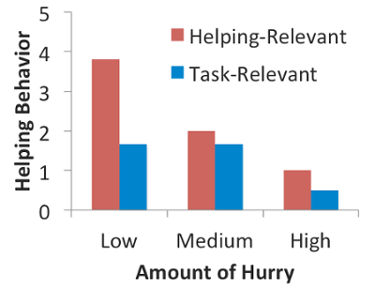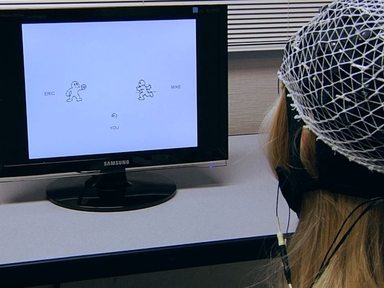Analyzing Situations in Helping Behavior
Genel Bakış
Source: Julian Wills & Jay Van Bavel—New York University
Social psychologists and personality psychologists both attempt to predict human behavior, but they focus on very different factors. Whereas personality psychologists focus on how personality traits, character, and individual differences affect behavior, social psychologists focus primarily on the power of social situations in shaping behavior.
We often underestimate the role that social situations can play in determining behavior. We often believe that people who smile are pleasant and happy, people who act rudely are mean, and people who stumble in the street are clumsy. Social psychologists have repeatedly demonstrated that these beliefs may be unfounded, and instead emphasize the importance of the social context in which behavior takes place.
Why are some people more apt to help people in need than others? Most of us would surmise it is a function of their personalities—some people are more inclined to help than others. However, psychological research shows that the social situation is often more likely to influence a person’s inclination to be helpful than their personality (which includes religiosity and ethics).
The classic experiment of Darley and Batson tested the Biblical parable of the Good Samaritan in which a priest and a Levite—two pious, upstanding citizens—passed by an injured man in need, whereas a non-religious Samaritan stopped to help.1
This video highlights some of the experimental techniques used by Darley and Batson in the difficult task of separating personality and situational factors when analyzing human behavior.
İlkeler
The American Psychological Association defines personality as the individual differences in characteristic patterns of thinking, feeling and behaving. The study of personality focuses on two broad areas: One is understanding individual differences in particular personality characteristics, such as sociability or irritability. The other is understanding how the various parts of a person come together as a whole.
Situational factors, also known as external factors, do not occur from within a person as with personality, but rather include the many facets of a person’s external environment.
Prosedür
1. Participant Recruitment
- Conduct a power analysis and recruit a sufficient number of participants from a pool of seminary students aged 18-50.
- Randomly assign participants to one of six experimental conditions detailed below.
2. Data Collection
- Since much of the experiment occurs outside, ensure consistent daylight and weather conditions while conducting the procedure with each participant.
- Ask them to complete a series of questionnaires that measure individual differences in religiosity (six total).
- Manipulate two independent variables: Type of speech that the participants are told they will have to give (speech type) and whether the participants are being rushed to give said speech (hurry).
- Variable 1: Speech type
- Tell half of the participants that they will be giving a speech on their career aspirations and that they are free to structure the brief 3-5 min speech however they like.
- Provide the participant 3 min to consider what to say.
- Tell the other half of the participants that they will be delivering a speech about the Good Samaritan parable.
- Give the latter group a copy of the Good Samaritan passage.
- Tell the participant that they are free to structure the 3-5 minute speech however they like.
- Provide them 3 min to consider what to say.
- Tell half of the participants that they will be giving a speech on their career aspirations and that they are free to structure the brief 3-5 min speech however they like.
- Variable 2: Hurry. Participants are told that the speech is to be delivered across campus.
- Low-hurry: Tell a third of the participants that once they arrive to give the speech, they will likely have to wait a little while.
- Medium-hurry: Tell a third of the participants that once they arrive they will be giving the speech right away.
- High-hurry: Tell a third of the participants that they are already late for the speech and that they should hurry over.
- Variable 1: Speech type
- Dependent measure: En route to the second location, participants come across an individual who is lying in an alley in apparent pain and need of help.
- This person is in league with the experimenters (a “confederate”), is feigning pain, and is trained to observe and systematically record the participant’s behavior, quantifying the degree to which the participant helped.
- Specifically, have the confederate rate each participant on a scale of helping behavior (primary dependent variable) as follows:
1= Participant fails to notice them.
2= Noticed the participant but does not offer aid
3= Did not stop but helped indirectly, e.g., told someone else that an individual was in need of help
4= Stopped and asked if they needed help
5= Stopped and insisted on taking the individual inside to a safe location and then left
6= Stopped and refused to leave the individual’s side until help was obtained
- Debriefing: After arriving at the speech location, tell the participant about the exact nature of the study, including the deception involved, and the reasons for the deception.
3. Data Analysis
- Compare the degree of helping as a function of the speech type and the amount of hurry the participant was in.
Sonuçlar
An analysis of variance revealed a main effect of situational hurry, such that as hurry increased, participants were less helpful to the person in the alley (Figure 1). That is, participants who were not in a hurry helped more, those who were in somewhat of a hurry helped less, and those who were in a big hurry helped the least. The type of speech participants were to give did not significantly influence helping. Moreover, there was no significant interaction observed between speech type and amount of hurry. Finally, the degree of helping was not significantly predicted by any of the individual difference measures of religiosity.

Figure 1: Average Amount of Helping Based on Speech Content and Amount of Hurry.
The amount of helping behavior (y-axis) is plotted for participants assigned to each of the three situational “hurry” conditions (x-axis). Red bars indicate participants assigned to give the helping-relevant speech (i.e., The Good Samaritan) whereas blue bars represent subjects giving the task-relevant (i.e., career aspiration) speech. The main effect of the hurry manipulation was significant at the conventional alpha = 0.05 level. Neither the main effect of speech type nor the interaction between speech type and hurry amount achieved conventional significance. Plotted values were reproduced from Table 1 in the original Darley and Batson article.1
Başvuru ve Özet
Seminary students are training for a profession where helping and empathy is typically expected. When asked to give a speech related to either helping or their career, the type of speech did not predict their helping behavior. Instead, the more students were asked to hurry, the less helpful they were. Moreover, individual differences in religiosity did not predict helping behavior. People tend to believe that individual differences and personality heavily impact behavior, but this study showed that situational factors can be far more influential.
Our interpretation of personality versus situational factors influences our actions and judgments on a daily basis. A principle of social psychology is the fundamental attribution error,2 which describes the tendency to attribute negative actions performed by other people to their personality, but negative actions performed by oneself to the current circumstances. A day-to-day example of this would be when someone attributes being cut off on the road to someone being a bad driver. While the person could be a bad driver, he or she may also just be in a hurry; situational factors could explain why the person is cutting people off on the road.
A much more striking example of an individual’s failure to see the significance of situations in shaping behaviors came in 2011. Wang Yue, a two-year old girl, was run over by a car in the street and dozens of people walking and driving by failed to help. The entire event was captured by a local video camera and Wang Yue eventually died from her injuries. We immediately think that the people who failed to help are callous, and indeed the Chinese media speculated that during the race to industrialize modern China, people had become more callous. But later video footage of the marketplace in which Wang Yue was run over reveals that the marketplace was brimming with noises, lights, and was generally busy. It might have been easy to fail to notice the little girl. Additionally, it is very likely that people believed that someone had already called for help.
These situations may have societal policy implications. Some societies have gone as far as to enact laws that require a duty to rescue. For instance in Canada, if you fail to aid someone in need of immediate physical assistance, e.g., a drowning victim, where there is no danger to yourself or a third person, you could be found guilty of a federal crime.
Atla...
Bu koleksiyondaki videolar:

Now Playing
Analyzing Situations in Helping Behavior
Social Psychology
42.3K Görüntüleme Sayısı

Analyzing Situations in Helping Behavior
Social Psychology
42.3K Görüntüleme Sayısı

Ostracism: Effects of Being Ignored Over the Internet
Social Psychology
10.6K Görüntüleme Sayısı

Devam eden Bilgisayarlı Toplumsal Etkileşim sırasında Sinir ve Davranış Aktivite Ölçüm: Olay-İlişkili Beyin Olanaklarının incelenmesi
Social Psychology
13.8K Görüntüleme Sayısı
JoVE Hakkında
Telif Hakkı © 2020 MyJove Corporation. Tüm hakları saklıdır